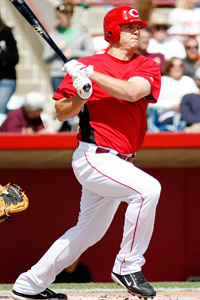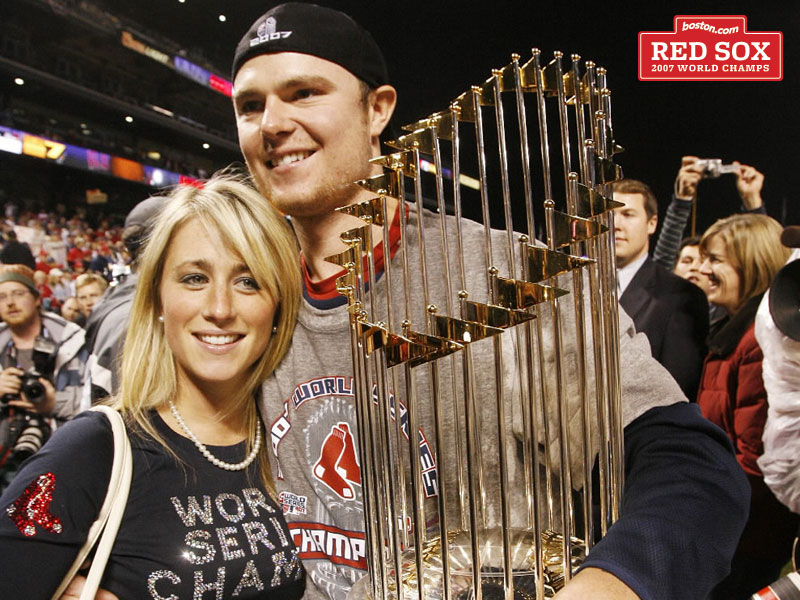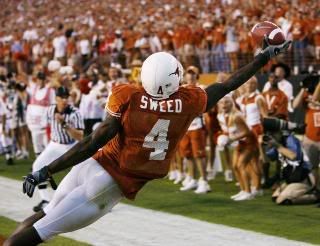TacklesOffensive tackle may have featured some of the most talented players in th

e draft. There were seven tackles taken in the first round, including the Miami Dolphins selection of Jake Long with the first overall pick in the draft. While there were plenty of tackles taken in round 1, none were selected in the second round, and only one was selected in the third round.
The Dolphins made the Michigan tackle Long the first overall selection of the 2008 NFL Draft. The Dolphins are hoping that Long will be the bookend tackle he was at Michigan, where he was called for just one holding penalty in his four years as a Wolverine. Long's impressive resume also includes two first team All-America selections and two Big Ten Lineman of the Year awards. The Dolphins hope Long will be a fixture for them at left tackle for the next 15 years, where long will likely protect his former Michigan teammate Chad Henne. Overall, the Dolphins could have made the safest pick. Long's strength and athleticism will make for a smooth adjustment to life in the NFL.
The next offensive tackle selected was Ryan Clady of Boise State. Clady was chosen by the Denver Broncos, looking for a bookend tackle to protect young quarterback Jay Cutler. The knock on Clady is whether he will be able to make a swift adjustment to NFL defensive ends after not facing the best collegiate competition at Boise State. However, there is no reason to believe that Clady has the potential and ability to be a Pro Bowl NFL tackle. He has great athleticism and a tremendous work ethic, which will end up being a tremendous help to him as he gets adjusted to NFL life.
Two picks after the Denver selection, the Chicago Bears surprised many draft experts by not taking a running back or quarterback, instead taking Vanderbilt tackle Chris Williams. While Williams is very athletic for an offensive lineman, he does have plenty of strength questions as he only did 21 bench press reps at the NFL combine. Unless Williams gets stronger, he will struggle to be an effective tackle in the NFL. However, his great athleticism and mobility give him tremendous potential if he does get stronger.
The Detroit Lions made Boston College tackle Gosder Cherilus the next tackle selected, at pick number 33. Cherilus is another athletic tackle, but he will need to be a right tackle in the NFL to be effective because his form is not great. Cherilus, however, is not afraid to finish off blocks and that mean streak will be of great benefit to him in the NFL. Overall, if the Lions put Cherilus at right tackle, they could have a very productive player at that position for many years to come.
Massive tackle Jeff Otah was the next tackle taken off the board, at pick 19 by the Ca

rolina Panthers. The Panthers could have a very, very impressive player on their hands if Otah continues to rapidly develop like he did at Pittsburgh in college. Otah does not possess very good athleticism, but what makes him a good tackle is his strength and pure power. He is still very unpolished, as he did not start playing football at Pitt until 2006. However, if Carolina gives him time to develop, Otah has the potential to be one of the most dominant tackles in the NFL.
At pick 21, the Atlanta Falcons reached for USC tackle Sam Baker. Baker is a very reliable tackle, having been a four year starter for the Trojans. While he doesn't do anything to make him stand out, he does have enough talent to be a solid NFL starter for Atlanta. Baker has a major task at hand, having to protect franchise quarterback Matt Ryan. He should be able to handle any kind of pressure though, as a USC-alum, he has plenty of experience protecting quarterbacks in the limelight.
The final tackle selection of the first round was made by the Houston Texans, who took Virginia Tech tackle Duane Brown. The Texans may have fallen too much in love with Brown's potential, which is immense. Despite that, Brown is a former tight end that lacks strength to be a good NFL tackle right now. However, is he can add some muscle, Brown could become one of the best tackles of this draft class. He is incredibly athletic and fast, but he is way too inexperienced and not strong enough to be taken in the first round.
The rest of the tackle pool was very weak, as there were no other notable tackles taken in the draft. In fact, the next tackle selected was John Greco from Toledo by the Rams in round 3. Despite its lack of depth, the tackles in this draft class could give many teams some bookend tackles for years to come.
Guards/CenterLike that of the tackle pool, the guards and centers in the 2008 NFL Draft were relatively weak. Only one it seems, has a definite chance to be a very good NFL starter. However, the others should end up as either solid starters or very good backups for their respective teams.
The first interior lineman selected was Virginia guard Branden Albert. Albert, taken by

the Kansas City Chiefs at pick 15, has the potential to develop into an extremely good NFL starter very quickly for Kansas City. He possesses great quickness and athletic ability, and also has enough versatility to move to tackle if possible. As soon as Albert learns to use some of his untapped power potential, he will become one of the dominant guards in the NFL.
The next guard taken was USC guard Chilo Rachal. Rachal, selected by the San Francisco 49ers, does not possess ideal athleticism for a guard at the NFL level. In order to develop into an adequate NFL starter, Rachal will need to continue to use solid blocking form. However, he should become an important part to a young and developing San Francisco line, and he has the potential to be a solid NFL starter.
The last guard of note was Rutgers guard Jeremy Zuttah. If nothing else, Zuttah will give the Tampa Bay Bucs the ability to play any position on the line except center. Zuttah did not allow a sack in his final two seasons at Rutgers, but despite that his lack of size and athleticism will make him struggle to be an exceptional NFL starting guard. However, Zuttah will provide for
tremendous depth for the Tampa Bay line and he will give them an excellent backup lineman.
The only center of note taken in the draft was Arizona State center Mike Pollack. Pollack, taken by the Indianapolis Colts, will be given some time to develop as the future Colt center behind current Pro Bowl center Jeff Saturday. Once he begins to start, Pollack could end up being a very good center to protect future Hall of Famer Peyton Manning. He is a very good run and pass blocker, and possesses very good athleticism. Despite the fact that he does not have great strength, Pollack should become a very good NFL starting center for the Colts.
The interior offensive lineman draft class was both lacking talent and depth. Branden Albert almost certainly will end up being the best interior lineman, and he has the talent to be the best lineman of the 2008 class. Mike Pollack will give the Colts a very solid starter, but all other interior lineman will likely struggle as starters, but they should make very good backups for NFL teams.
Next: NFL Draft- Defensive Tackle
 One of the biggest surprises of the 2008 Major League season has been Chicago White Sox outfielder Carlos Quentin. Quentin has been the biggest reason for the White Sox surge into first place in the AL Central. He currently ranks first in the American League in home runs with 14, second in RBIs with 48, second in slugging percentage (.587) and On-base plus slugging percentage (.988), and sixth in both runs (35), and on-base percentage (.402). Quentin has created a bigger impact however, in the standings. The White Sox surprisingly are perched in first place in the AL Central with a 30-23 record, 2 games ahead of the Minnesota Twins and just 1.5 games behind the Tampa Bay Rays (yes, you read that right) for the best record in baseball.
One of the biggest surprises of the 2008 Major League season has been Chicago White Sox outfielder Carlos Quentin. Quentin has been the biggest reason for the White Sox surge into first place in the AL Central. He currently ranks first in the American League in home runs with 14, second in RBIs with 48, second in slugging percentage (.587) and On-base plus slugging percentage (.988), and sixth in both runs (35), and on-base percentage (.402). Quentin has created a bigger impact however, in the standings. The White Sox surprisingly are perched in first place in the AL Central with a 30-23 record, 2 games ahead of the Minnesota Twins and just 1.5 games behind the Tampa Bay Rays (yes, you read that right) for the best record in baseball. aging lineup. They found one cheap into Quentin. Just two years prior, Quentin was rated one of the top prospects in baseball and was one of the crown jewels of the Arizona Diamondbacks farm system. Somehow, Quentin fell out of favor in the Valley of the Sun and was dealt to Chicago to make room for 20-year old superprospect Justin Upton. In Chicago, Quentin was finally given the oppurtunity to play. He quickly gave the South Side of Chicago some hope to be a World Series contender in 2008.
aging lineup. They found one cheap into Quentin. Just two years prior, Quentin was rated one of the top prospects in baseball and was one of the crown jewels of the Arizona Diamondbacks farm system. Somehow, Quentin fell out of favor in the Valley of the Sun and was dealt to Chicago to make room for 20-year old superprospect Justin Upton. In Chicago, Quentin was finally given the oppurtunity to play. He quickly gave the South Side of Chicago some hope to be a World Series contender in 2008.  aging lineup. They found one cheap into Quentin. Just two years prior, Quentin was rated one of the top prospects in baseball and was one of the crown jewels of the Arizona Diamondbacks farm system. Somehow, Quentin fell out of favor in the Valley of the Sun and was dealt to Chicago to make room for 20-year old superprospect Justin Upton. In Chicago, Quentin was finally given the oppurtunity to play. He quickly gave the South Side of Chicago some hope to be a World Series contender in 2008.
aging lineup. They found one cheap into Quentin. Just two years prior, Quentin was rated one of the top prospects in baseball and was one of the crown jewels of the Arizona Diamondbacks farm system. Somehow, Quentin fell out of favor in the Valley of the Sun and was dealt to Chicago to make room for 20-year old superprospect Justin Upton. In Chicago, Quentin was finally given the oppurtunity to play. He quickly gave the South Side of Chicago some hope to be a World Series contender in 2008. 











































